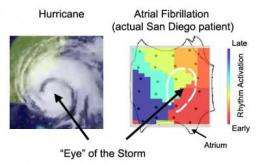New targeting technology improves outcomes for patients with atrial fibrillation

In a landmark study of atrial fibrillation, researchers from UCLA, UC San Diego and Indiana University report having found for the first time that these irregular heart rhythms are caused by small electrical sources within the heart, in the form of electrical spinning tops ("rotors") or focal beats.
Importantly, they found a way of detecting these key electrical sources and of shutting them down in minutes using a precisely targeted therapy with long-lasting results.
The team, which included cardiologists, physicists and bioengineers, reports the findings in the July 19 issue of the Journal of the American College of Cardiology as part of the CONFIRM trial (Conventional Ablation for Atrial Fibrillation With or Without Focal Impulse and Rotor Modulation).
Currently, many atrial fibrillation patients treated with standard therapies will experience a recurrence due to the difficulty of finding the arrhythmia's source. The new research will help cardiologists better target and treat arrhythmias.
The CONFIRM study examined 107 patients with atrial fibrillation who had been referred for a non-surgical catheter ablation procedure. During this procedure, doctors thread a wire with a metal-tipped catheter through the body, from a vein in the groin to the heart, to apply heat to the area of the heart producing the arrhythmia to stop it.
In one group of patients, the team used the new technique to help perform very small, precise burns — called focal impulse and rotor modulation, or FIRM — that were aimed directly at the fundamental source of the arrhythmia: the tiny electrical disturbances in the heart called focal beats or 'rotors' that look like mini-tornadoes or spinning tops. Rotors can be likened to an "eye of a storm" shown in this study to cause atrial fibrillation. Remarkably, this new procedure shut down or very significantly slowed atrial fibrillation in 86 percent of patients in an average of just 2.5 minutes.
As a comparison, conventional catheter procedures were performed in a second group of patients. Since this approach is less targeted, it involved hours of treatment over larger regions in the heart and often did not shut down the atrial fibrillation.
To track outcomes, patients received an implanted ECG monitor that very accurately assessed their heart rhythms over time. The researchers found that after two years, the FIRM-guided group had an 82.4 percent freedom from atrial fibrillation episodes, compared with only 44.9 percent freedom in the group that received standard therapy.
The new targeted method demonstrated an 86 percent improvement over the conventional method.
"We are very excited by this trial, which for the first time shows that atrial fibrillation is maintained by small electrical hotspots, where brief FIRM guided ablation can shut down the arrhythmia and bring the heart back to a normal rhythm after only minutes of ablation," said lead author Dr. Sanjiv Narayan, a professor of medicine at UC San Diego, visiting professor at the UCLA Cardiac Arrhythmia Center, and director of electrophysiology at the San Diego Veterans Affairs Medical Center.
"The results of this trial, with an 80 percent ablation success rate after a single procedure, are very gratifying," said study author Dr. Kalyanam Shivkumar, director of the UCLA Cardiac Arrhythmia Center and a professor of medicine and radiological sciences at UCLA. "This is the dawn of a new phase of managing this common arrhythmia that is mechanism-based."

















